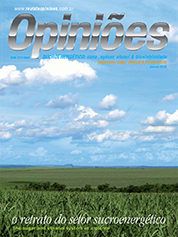Edmundo Coelho Barbosa
President of Sindalcool - Paraíba
Op-AA-25
Scenarios and opportunities in the sugar-based energy industry
The current sugarcane production scenario shows annual average growth of 9% from the 2006/2007 to the 2010/2011 harvest season, totaling projected 595 million tons. Sugar production has grown 3% per year. Annual average ethanol production growth has been around 20% - a positive scenario in terms of gains in scale and production increases due to improvements in processes, mainly in the case of sugar.
In the field, one must set targets for the adoption of early growth varieties, with better total recoverable sugar levels, early on in the first 15 days of the cutting periods, because a long low-yield crushing period still lies ahead. The dual-fuel (gasoline and ethanol) car fleet in 2010 is already at 13.7 million vehicles – 43.6% of the total fleet – and is expected to surpass 31 million vehicles in 2020, reaching 73.8% of the total fleet, warranting continuous high demand both for hydrated and anhydrous ethanol.
To meet this growth in demand, 40 to 50 million additional tons of sugarcane will be needed per year, i.e., 10 to 15 new mills will have to be installed. For 2020, estimates place consumption at 9.3 billion liters of anhydrous ethanol and 32.5 billion liters of hydrated ethanol. Investments needed for this volume are estimated at US$ 35.3 billion, generated by this business activity and supplemented with financing.
Such financing, in the current scenario, will be used to increase areas planted with sugarcane by another 4 million hectares. If on the one hand exportable surplus is smaller in the current harvest, on the other hand growth in ethanol sales to the ethanol-based chemical industry are quite encouraging and the already contracted demand of ethanol to be converted to acetic acid, ethyl acetate, ETBE, glycol ether and other derivative products will grow from 323 million liters in 2010 to more than 2.5 billion liters in 2015. Another 1.9 billion liters of ethanol will be used for bio-plastics.
The chemical industry will become a preferential partner in view of current barriers in the international market. Business transactions with the chemical industry are beginning to occur through the BMF BOVESPA Stock Exchange. Acetic acid imports in 2010 are at the 100,000 tons/year level. This is a volume the sugar-based energy industry needs to achieve.
The ethanol-acetic acid conversion rate is 1:1, so such imports could be avoided. The sugar-based chemical industry could render even higher gains. Brazil as yet does not produce xantham gum, a product resulting from the slow fermentation of saccharose, whose price in international markets is above US$ 4,500/ton.
With the current euphoria due to the pre-salt oil reserves, the industry is expected to diversify to reduce risks. In Brazil, the largest xantham gum importer (from China) is Petrobras. As for citric acid, the Brazilian production is still small. The transformation of 900,000 tons of sugarcane into 60,000 tons of citric acid results in annual revenues of US$ 90 million.
Furfural is another biomass derivative, which started to be manufactured in the United States in 1922, when the American government sought more self-sufficiency of industry and better utilization of plantation leftovers in the fields. The Quaker Oats Company, a traditional agribusiness company, started manufacturing it from oat shells and corn cobs.
Furfural has several large scale applications, due to its characteristics of solubility and easy recovery by steam distillation. Furfural has the unique characteristic of dissolving other olefins and aromatic and non-saturated products. Nowadays, all large oil companies use furfural as a selective solvent in the refining of lubricant oils. This technology allows the production of high quality oil with improved properties of the viscosity-temperature binomial.
Aromatic mercaptans, polar components, are extracted from oil using furfural. This derivative can also be used as a discoloring agent to refine unprocessed wood resin, and for manufacturing aeronautical resins. Brazil as yet does not produce furfural on an industrial scale, nor furfuryl alcohol. The raw material for furfural would be bagasse, straw and leftovers. The industry also produces carbon dioxide from fermentation that may be used in the super critical state, with major industrial advantages.
These are some of the possibilities to increase EBITDA. The task consists of converting this potential to cash. Society can undertake several initiatives in favor of this clean and renewable energy: the “CIDE” tax must be consolidated as an environmental tax; the ICMS tax on ethanol fuel must be reduced and bio-electricity must pay better prices. One also needs to valorize state-of-the-art technology rather than dirty thermal plants and support employment in agriculture by producing ethanol, sugar and electricity through co-generation.




